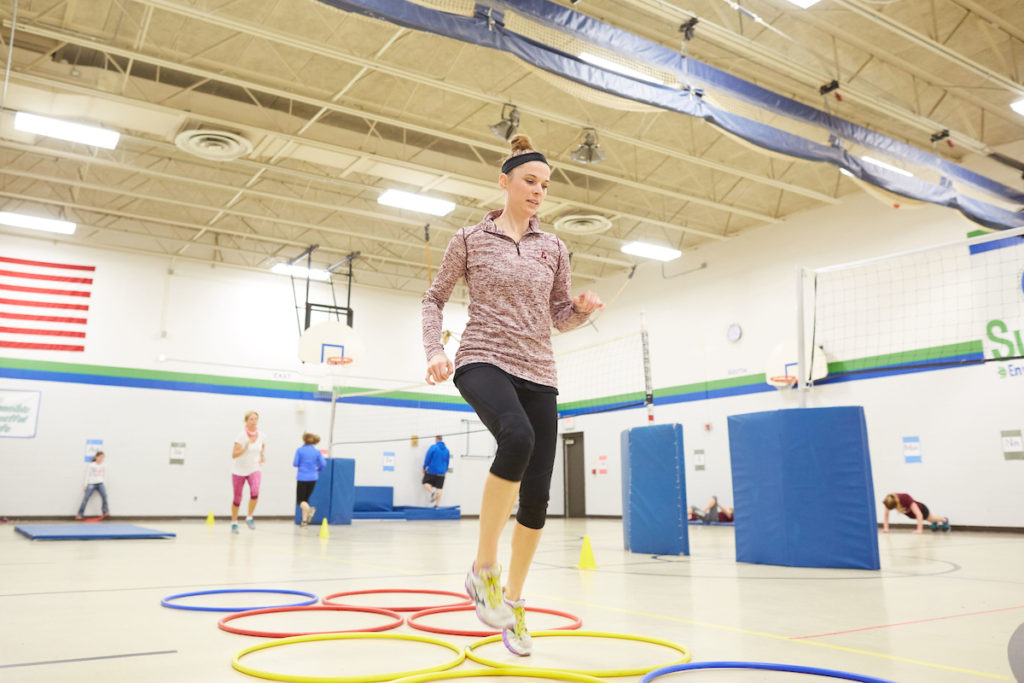
UWL graduate student Elizabeth Skaer helps lead a free fitness program for Summit Elementary School staff. The program is one of many community health and wellness programs led by UWL Physical Therapy students this semester.
La Crosse, Wis.—UW-La Crosse (UWL) graduate student Elizabeth Skaer yells “Go!” and the gym is a wave of motion.
Fluorescent lights beat down as Summit Elementary School staff members begin high stepping, jumping rope and crunching into sit ups.
Special Education teacher Kasey Pomeroy is panting, but smiling. She wears a hot pink tank top with the words, “When in doubt. Work it out.” Pomeroy didn’t always feel that way. Months ago, before UWL students launched a fitness program at her workplace, she wasn’t working out at all. She couldn’t. Finding time to go to the gym with a toddler wasn’t feasible.
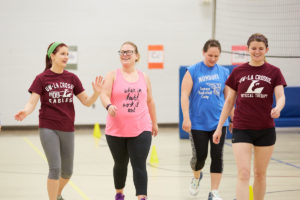
Summit Elementary School Special Education teacher Kasey Pomeroy, center, takes warm up laps with UWL Physical Therapy Students Brenna Dubick, left, and Abigail Bishop. The Physical Therapy students helped design a free and convenient fitness program at the La Crosse school to motivate more adult physical activity.
But that all changed at the end of January when four students from UWL’s physical therapy program approached the school with a fitness program open to any staff. It would be free, right after work, and children could come. With such a convenient new option, Pomeroy and others say they had no reason not to give it a try.
“It’s scheduled and it’s right here,” notes Pomeroy. “It’s nice that I don’t have to figure it all out. I just bring clothes and join in.”
Summit’s fitness program is just one of many health and wellness programs happening throughout the community courtesy of UWL Physical Therapy Department students in Professor Heather Fortuine’s class. Students are teaching people how to find accurate health information online at the La Crosse Public Library, teaching Aquinas High School athletes about ACL injury prevention and promoting physical activity in adolescents with disabilities through a partnership with the adaptive sport league.
All of the student groups began their community projects by looking for health gaps in the community based on a federal government Healthy People 2020 website, which includes studies and resources related to health. Then, students used their physical therapy prowess to figure out how to fill those gaps.
The group that launched the Summit fitness program found a considerable health gap. The vast majority of adults do not get get enough daily physical activity. In fact, about 80 percent of adults don’t meet the science-based physical activity guidelines created by the U.S. Department of Health and Human Services. For overall health, the guidelines recommend at least 150 minutes of moderate–vigorous physical activity per week plus two days a week of strength training, according to the Healthy People 2020 website.
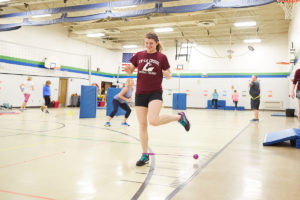
UWL Physical Therapy student Abigail Bishop says setting up a fitness program at La Crosse’s Summit Elementary School has challenged her to get creative and provide variety of exercises to keep staff motivated.
The UWL PT student’s goal with the Summit Elementary School group was to increase aerobic physical activity, and make it sustainable — long after the fitness program ends later in the spring. They’ve done that with a unique approach to a workout class — coupling education with physical activity, says Skaer, one of the students heading the program at Summit. Educational tidbits come during break times between circuits. Students cover topics such as how to monitor physical activity, set achievable goals and identify barriers that get in the way of working out — like not having the time or money to go to the gym.
PT students say they’re already getting signs that adding an educational component is worth their time. At the start of their program, when the fitness class had to be cancelled, no one showed up. But later in the semester, when the class didn’t meet over UWL’s spring break, the Summit staff still all came to the gym. Without their UWL student leaders, they made up their own workout routine that week.
“This has been interesting. It confirms a lot of things we’ve been learning in class,” says Physical Therapy student Abigail Bishop. “People have difficulty with motivation and we can help them by doing more than just saying “go, go, go. We gave them skills to overcome barriers — It was encouraging to see that they exercised over break.”
It’s also encouraging that many in the group have had weight loss or are on a path to healthier living, says Nicholas O’Keefe, physical education teacher at Summit. “I’ve definitely gotten more active,” he adds.
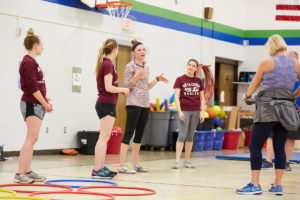
UWL Physical Therapy graduate student Elizabeth Skaer shares educational information during a break time in the circuit training at Summit Elementary School in La Crosse. The fitness program the UWL Physical Therapy students created has a unique blend of aerobic activity and education. It is one of many PT program health and wellness initiatives UWL students are creating throughout the community.
Pomeroy says she’s even set up her own circuit stations at home. Since January, she has lost 37 pounds, which she attributes to a combination of Weight Watchers and her new workout routine. “I feel like I have way more energy now,” she says.
Professor Fortuine says she is proud of the work UWL Physical Therapy students are doing in the community. “They have such generous, caring hearts and the projects they have selected really highlight this,” she says. “They are role models for our community, and I expect they will all go on to make a great impact on this lives of their future patients and the profession of physical therapy.”
The PT students expect the experience to come in handy when they begin their careers. It’s taught them how to build a service learning project from the ground up from setting an objective, to conducting research and targeting a population, along with finding community partners to begin working on a goal. Moreover, it has taught them that combining their expertise with action can motivate people and help fill a health need.
Later in the semester, they plan to start talking to the Summit staff about what an aerobic training program would look like that the staff could do independently.
“As future physical therapists, we are movement experts,” says Skaer. “It is important for physical therapists to identify needs in community and use our training to improve how our communities move.”
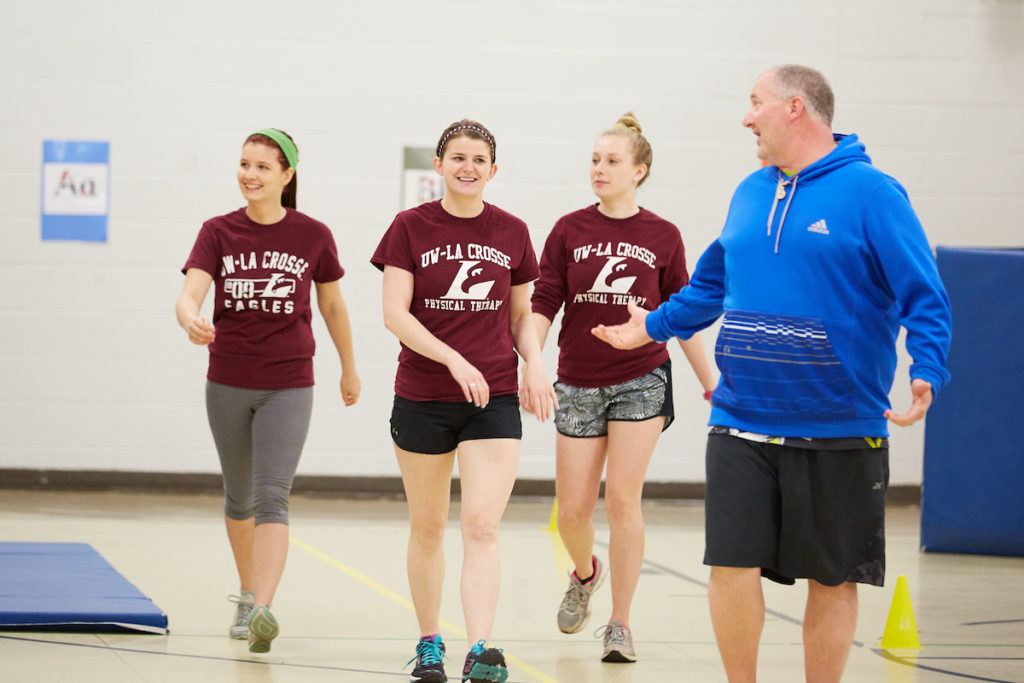
Physical Therapy graduate students, from left, Brenna Dubick, Abigail Bishop and Sydnie Kraus, take a warm up lap with Nicholas O’Keefe, physical education teacher at Summit Elementary School. The three UWL Physical Therapy students designed a fitness program at the La Crosse school along with student Elizabeth Skaer.
